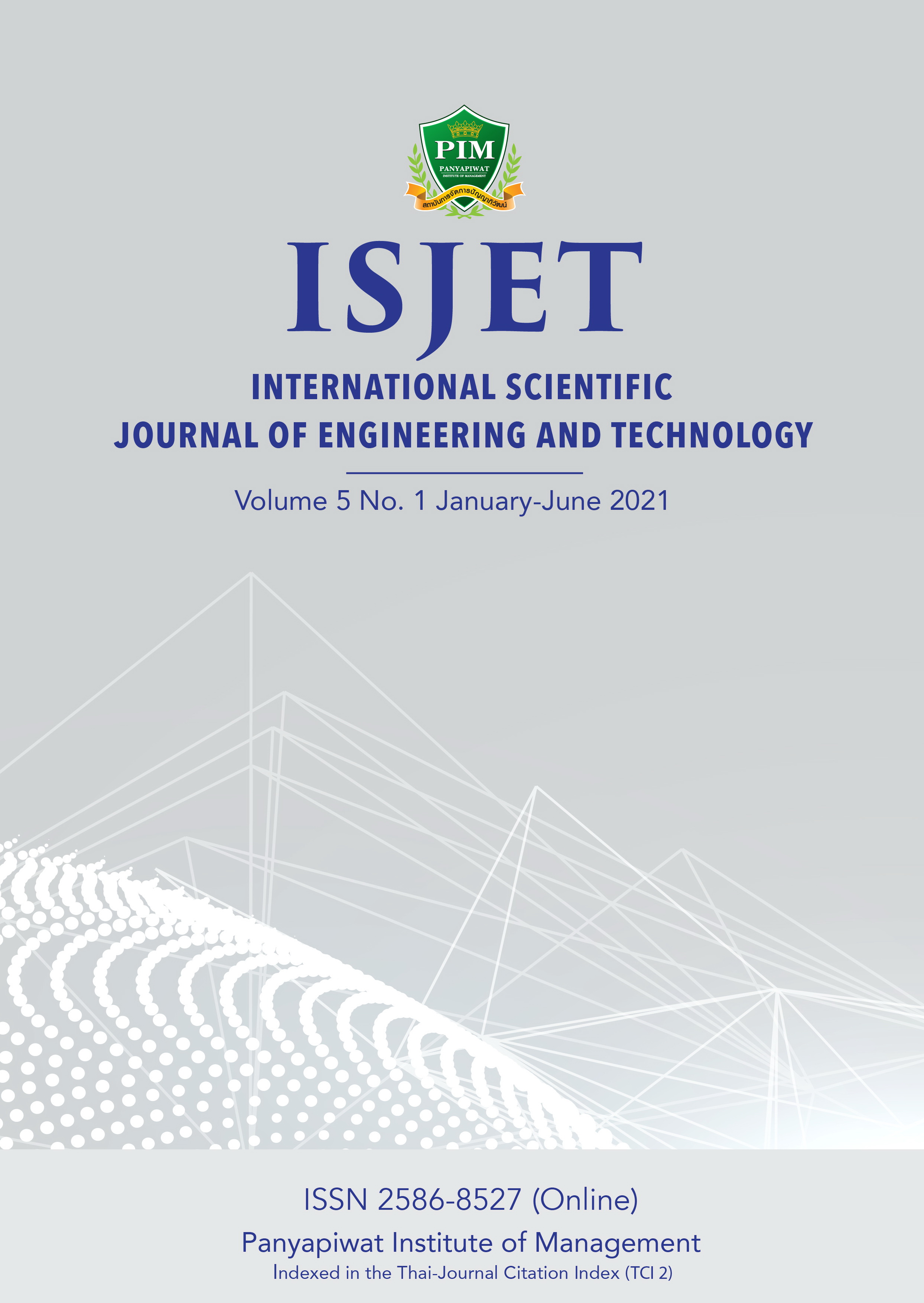Effects of Indole Butyric Acid (IBA) and Naphathalene Acetic Acid (NAA) on Rooting and Shooting of Jiaogulan (Gymnanthemum extensum) Cutting Stem
Main Article Content
Abstract
Abstract—The effects of IBA and NAA on rooting and shooting of the Bitter leaf tree (Gymnanthemum extensum) cutting stems were investigated. The stems were obtained from a private garden in Chiang Mai Province. The 25-cm long cutting stems were dipped into distilled water (control), IBA, and NAA with 250, 500, 1000, 2000, and 3000 ppm concentrations for 30 minutes and put in plastic cups in the plant nursery (Program of Biotechnology, Faculty of Science, Maejo University, Chiang Mai) from April to May of 2019. The experiment was performed in a completely randomized design (CRD). The data was collected 30 days after treatments. The result showed that the cutting stem treated with 0ppm (control), 250 ppm of IBA, and 500ppm of IBA gave rise to the highest percentage of rooting (100%). In contrast, the cutting stems treated with IBA at 1,000 and 2,000 ppm concentrations yielded 80% of rooting. NAA at 250, 500, 1,000, and 2,000ppm concentrations gave rise to 73, 73, 73, and 66.7% rooting, respectively. On the other hand, 3000 ppm of NAA provided the lowest percentage of rooting at 53.3%, respectively. Two hundred and fifty ppm of NAA gave the highest average number of roots per cutting compared to the other treatments. The average root length and average root width of control and all treatments were not significantly different (P<0.5). The control, IBA, and NAA at 250, 500, 1,000, and 2,000 ppm concentrations gave the highest percentage of shooting (93 - 100%).
Article Details
เนื้อหาข้อมูล
References
M. Blumert and J. Lui, Jiaogulan (Gynostemum pentaphylum): China’s immortality herb. CA: Torchlight
Publishing, 1999, pp. 1-80.
S. Bunwong, P. Chantaranothai, and S. C. Keeley, “Revisions and key to the Vernonieae (Compositae) of Thailand,” PhytoKeys, vol. 37, pp. 25-101, May. 2014.
U. Niramol, C. Penkwan, H. Vichia et al., “Optimization of Chemical properties, Sensory Descriptive and Consumer Acceptance of Jiaogulan tea Using Response Surface Methodology (RSM),” Chiang Mai Journal Natural of Science, vol. 6, no. 1, pp. 101-119, Jan. 2007.
C. O. Olaiya and O. Osonubi, “Effects of Pre-sowing seed Treatments on Tomato (Lycopersicon esculentum (L.) Mill) Seedling Emergence.” International Journal Engineering and Technology, vol. 1, no. 4, pp. 321-323, Jan. 2009.
A. Waheed, F. S. Hamid, F. M. Abbassi et al., “Effect of Indole Butyric Acid (IBA) on Early Root Formation
(Tomato “Sahil” Hybrid) Cuttings,” Journal of Materials and Environmental Science, vol. 6, no. 1, pp. 272-279, Jan.
P. Sokhuma, S. Intorrathhed, and R. Phonpakdee, “Cholesterol content and fatty acid composition in Longissimus dorsi muscle of purebred and crossbred pigs,” International
Journal of Agriculture Technology, vol. 14, no. 7, pp. 1939-1948, Dec. 2018.
D. G. Lopez, J. W. Jimmenez, A. P. Lomeli, and J. E. R. Perez, “Vegetative Propagation of Husk Tomato (Physalis
ixocarpa Brot.) by Rooting Cutting,” Agricultura Tecnica. En. Mexico, vol. 27, no. 1, pp. 27-33, Jun. 2001.
R. Steel, J. Torrie, and D. Dickey, Principles and Procedures of Statistics: A Biometrical Approach, 2nd ed., New York, USA: McGraw-Hill, 1980, p. 633.
Z. Tchoundjeu, M. L. Avana, R. R. B. Laekey, and A. J. Simons, “Vegetative Propagation of Prunnus Africana
Effects of rooting medium, auxin concentrations and leaf area,” Agrofor. Syst, vol. 54, no. 3, pp. 183-192, Jan. 2002.
L. Nagash, “Successful vegetative Propagation techniques for the Threatened Africa pencil cedar (Juniperus procem Hoechst ex,” Forest Ecology and Management, vol. 161, no.1-3, pp. 53-64, May. 2002.
S. Kochhar, S. E. Signh, and V. R. Kochhar, “Effect of Auxins and Associated biochemical change during clonal propagation of the biofule plant,” Jatropha cucas Biomass and Bioenergy, vol. 32, no. 12, pp. 1136-1143, Dec. 2008.
V. Kesiri, A. Krishanamachairi, and L. Rangan, “Effect of auxins and adventitious rooting from stem cutting of candidate plus trees Pongamia pinnata (L.) a potential biodiesel plant,” Tress Structure and Function, vol. 23,
no. 3, pp. 597-604, Dec. 2008.
T. Berleth, E. Scarpella, and P. Prusinkiewicz, “Towards the system biology of auxin transport mediated patterning,” Trends in Plant Science, vol. 12, no. 4, pp. 151-159, Mar. 2007.
S. Puri and R. C. Verma, “Vegetative propagation of Dalbergia sisso Roxb. Using softwood and hardwood stem cutting,” Journal Arid Environ, vol. 34, no. 2, pp. 235-245, Oct. 1996.
R. R. B. Leakey, J. F. Mesen, Z. Techoundjeu et al., “Low
technology techniques for the vegetative propagation of tropical trees,” Commonwealth Forestry Review, vol. 69, no. 3, pp. 247-257, Dec. 1990.
H. T. Hartmann, D. E. Kester, Jr. F. T. Davies et al., Plant Propagation: Principles and Practices. Upper Saddle River, NJ: Pracitce Hall, 2002, p. 880. 2002.
O. F. Adekola and I. C. Akpan, “Effect of Growth Hormones on Sprouting and Rooting of Jatropha cucas I. Stem Cutting,” Journal Apply Science Mannage, vol. 16, no. 1, pp. 153-156,
Mar. 2012.
C. Jenjira, A. Panwipa, and T. Areya, “Effect of IBA and NAA on Rooting and Axillary Shoot Outgrowth of ‘Chiangmai
’ Mulberry (Morus alba Linn.) Stem Cutting,” KhonKhen Agriculture Journal, vol. 42. no. suppl. 3, pp. 162-167, Sep. 2014.
P. J. Davis, Plant Hormones and their roles in plant growth and development. Dordrecht, NL: Martinus Nijhoff Publishers, 1996, pp. 531-546.


